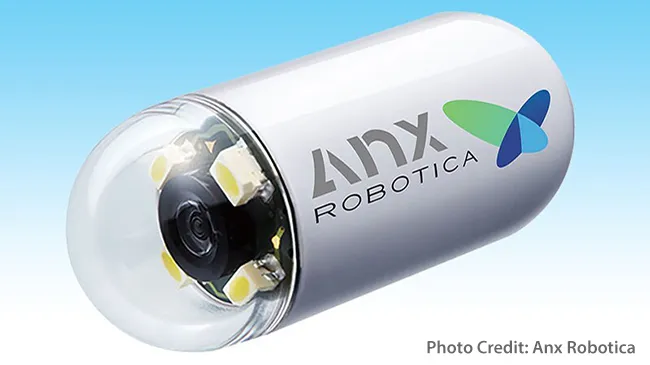June 23, 2023 – When emergency room patients complain of stomach pain, doctors have limited options. Scans and ultrasounds can’t show the inner lining of the digestive tract, so patients are often sent home without answers.
Upper endoscopies, where a flexible tube with a tiny camera is fed into the upper digestive tract, require anesthesia and can only be done by a gastroenterologist, so patients may be sent to another department, admitted to the hospital, or told to return another day. This can delay the diagnosis and treatment of potentially life-threatening conditions like stomach cancer or bleeding ulcers.
But a new technology could speed things up, making belly pain easier and faster to diagnose. It involves a tiny camera, a large magnet, and two video game-style joysticks. Known as magnetically controlled capsule endoscopy, the technology was recently tested in the U.S. for the first time.

It works like this: The patient swallows a magnetic, pill-sized device with a tiny camera. Then they lie on their back with a dome-shaped magnet hovering above their belly. Using the joysticks, a doctor manipulates the magnet, steering the capsule around the stomach and capturing images in real time that can be reviewed by an off-site gastroenterologist.
“I can almost grab onto the capsule and drag it across,” said study author Andrew Meltzer, MD, an emergency medicine professor at the George Washington School of Medicine & Health Sciences. “If I bring the magnet closer to the patient, the capsule will lift up toward the front of their stomach, and if I pull the magnet away, the capsule will drop down. I can also rotate the capsule around and look in all directions.”
In the pilot study, emergency room doctors were able to guide the capsule through the stomachs of 40 patients, identifying key stomach landmarks 95% percent of the time. The capsule’s wide-angle lens captures six pictures per second, “which actually looks like a relatively smooth video,” Meltzer said. Standard endoscopies later confirmed that the capsule did not overlook any high-risk lesions.
Capsule Endoscopy: A Rising Trend
The study builds on research of magnetic capsule endoscopy in China, where most hospitals already use the technology due to the country’s high stomach cancer rates. The tech, which has also been studied in Britain, Hungary, and Italy, has been shown effective in stomach cancer screenings. About 11,000 people in the U.S. die from stomach cancer each year.
“If this was as accurate as endoscopy, and the risks and cost to the patient were much lower, then maybe we’d consider more widespread screening for gastric cancer,” Meltzer said.
Since the early 2000s, capsule endoscopy has been used to evaluate the small bowel, and more recently, the colon, according to Shabana F. Pasha, MD, an expert in small-bowel endoscopy and a professor of medicine at Mayo Clinic Arizona. But these non-magnetic capsules are pushed along by gravity and peristalsis, the natural movement of the digestive tract, making them less effective in a large organ like the stomach.
“The upper GI tract has been very challenging to evaluate with capsules, due to our inability to control their movement. They basically stumble through the intestines,” said Pasha, who was not involved in the study.
“That’s where the joystick technology comes into play, where we are now able to maneuver magnetically controlled capsules and visualize the entire stomach and important landmarks in a noninvasive manner,” she said.
Meltzer cautions that larger studies are needed to confirm the capsule’s accuracy, including screenings of higher-risk patients, who might have dyspepsia or gastritis. The capsule can also use artificial intelligence to independently survey the entire stomach, without the need for joysticks.
Meltzer and researchers at the University of Massachusetts are doing follow-up studies of the capsule, but with a detachable tether that allows for examination of the lower esophagus.
“What’s cool about this is that it starts to mimic the capabilities of a traditional tube-based endoscopy, which we do commonly for patients who have upper abdominal pain,” he said.
In the future, the capsule could potentially biopsy and provide therapy for bleeding lesions. “All of that stuff down the road seems pretty exciting, almost like a little Mars Rover,” Meltzer said.
https://img.wbmdstatic.com/vim/live/webmd/consumer_assets/site_images/article_thumbnails/news/2023/06_2023/gut_camera/650x365_gut_camera.jpg
2023-06-23 19:31:01





